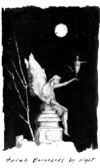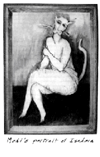
 Bill Richardson is no amateur punster, having been seasoned by years of on-air broadcasting experience as host of a much-bepunned early-afternoon CBC variety radio program. A veteran of several novels, his prose has garnered the Leacock Medal by virtue of its gleeful use of literature's lowest form of humour. It is therefore unsurprising that Waiting for Gertrude is a book that aspires to be the holy grail of puns, where the pursuit of reluctant smiles, irresistible guffaws and glorious groans takes utmost precedence.
Bill Richardson is no amateur punster, having been seasoned by years of on-air broadcasting experience as host of a much-bepunned early-afternoon CBC variety radio program. A veteran of several novels, his prose has garnered the Leacock Medal by virtue of its gleeful use of literature's lowest form of humour. It is therefore unsurprising that Waiting for Gertrude is a book that aspires to be the holy grail of puns, where the pursuit of reluctant smiles, irresistible guffaws and glorious groans takes utmost precedence.
Richardson possesses a delightfully demented mind. His radio show is nicknamed "Sad Goat" because, one idle day, he wondered what kind of acronym could be made out of the Vancouver office's telephone number. This anecdote is a suitable introduction to a man who has written a new novel casted by famous early twentieth century personalities reincarnated as felines inhabiting the cemetery of their collective interment, PFre-Lachaise in Paris. These felines range from chanteuse Edith Piaf to actress Sarah Bernhardt. Yes, on the surface this book is about the anthropomorphic strays of a famous graveyard, each possessing a personality matching that of a famous dead person buried nearby.
Waiting for Gertrude begins with the reincarnation-as-cat of Gertrude Stein's significant other, Alice B. Toklas, in PFre-Lachaise. In the first few pages Alice B. is returned rudely to the world amongst a litter of eight kittens. She and her sibs are offered to a hungry male, Jim Morrison the cat, pFre extraordinaire and magnetic nebula of PFre-Lachaise, by a cursing multiparous mom resentful of being burdened by yet another brood. Thus at the novel's inception is a major trope of children's literature: wicked, wicked parents. Morrison eats all but two kitties, sparing Alice B. (of course) and her sister, due to Alice B.'s courage. Richardson thus supplies another major character constituent of children's literature: the precocious and heroic youngster protagonist. Even the book's sentient-animal characters are staples of the genre.
Despite employing many of its conventions, Richardson's offering resists the easy stereotype of children's literature. Kiddies won't catch the many awful puns and send-ups of famous dead persons long remaindered from their stale pop-culture circles. Not many young adults out there will appreciate the irony of a reincarnated Marcel Proust possessing a species-enhanced sense of smell, self-employed as a private investigator, sniffing out suspects while never leaving his room; or Alice B. pining for Stein while wondering if the great lady weren't meant to come back as a dung beetle or a donkey, instead of a feline (Richardson makes much of Stein's mannishness); or La Fontaine as a doggerel-reciting tour guide with an inexhaustible verse itinerary composed in vaudevillian stanzas of aabb rhyme scheme.
Gertrude is best kept away from little ones, although La Fontaine's punchy poems, with their upbeat rhymes and singsong metre, are bread and butter to kidliterateurs: "Look! Here's Colette. Her Cheshire grin/ Suggests she's swallowed cream or gin./ Her smirk¨post coital¨plainly tells/ That someone's been in pussy's well." Juvenile rhymes featuring adult content are anathema to parents reading to their children during the bedtime ritual. A later incident in the book is similarly ear-covering. Oscar (Wilde) the Cat writes a letter to the masculine object of his affection: "I walked where the tight ranks of ancient ossuaries are falling into disrepair, leaning precariously, one against the other, like overcrowded teeth. (Indeed, they bear a striking resemblance to the mouth of a boy I knew in another place and another time; one who disappeared without a word, but not before I had taken care of his dental bills.)" Most explicit of all is an incantation commissioned by Alice B. from a murky cat sorceress which appears as a thinly-veiled carnal rite: "Bind mortar to pestle!/ Bind scabbard to sword./ Bind Tab A to Slot B! Bind arch unto trestle./ Bind flesh unto word./ Bind shore unto crashing sea!" Words like fecundity, blood (twice), and howl appear on the following page.
Kidlit? Remember the artist Lewis Carroll, nom de plume of Charles Dodgson, elevated pedophilia into a literary and photographic art. Richardson too peppers his pages with Bill Pechet illustrations featuring titles like "Chopin, In Mid-Nocturne" and "Isadora, bedlight with ribbons". His prose has a silly luminosity that, despite all the carnal lunacy of PFre-Lachaise's feral inhabitants, actually succeeds in making the central plot device¨Alice B.'s long, impatient wait for the reincarnation of her lover¨a sad and moving enterprise.
Gertrude's whimsical ribaldry is tempered by erudition; famous literary figures appear as glorious send-ups of themselves, the most memorable of these predictably being Oscar Wilde. Yet the erudition is carried by language that is sometimes staid. For example, a cat delivering mail in foul weather is described as "dumbly obedient to her pledge that no elemental inconvenience would impede her appointed rounds". More archaic is the instance when Alice B. (a cook in this feline world as in the one before, ha ha) instructs the reader in one of her recipes: "When the water has had its way with the yeast, add a soupcon of sugar, cover it up and let it obey its frothy imperative." When finished, the reader is told to "take a few recuperative moments." Elemental inconvenience? Frothy imperative? Recuperative moments? Part of such syntactical overreach stems from the frothy imperative to avoid clichT; the other part comes from the whimsical tone of the novel. Richardson uses formal diction as a vivifying tonic in the same grand tradition as British comedies of manners. He mostly succeeds, but some sentences read as ridiculously thesaurus-consulted, written in a declarative style best suited as a script meant for aural performance, where a sense of timing and proper vocal inflection can make all the difference.
Prime billing in this book goes not to the prima donna composers, painters, and writers of PFre-Lachaise. Instead, it goes to puns that range from subtle to grating. One of the most amusing of these involves a neutered Wilde the cat (a pun in himself) searching for Jim Morrison in the cemetery, calling: "Come out, come out, wherever you are!" Another gem is Alice B.'s overt remark to her non-reincarnated sister, Tristesse, "Isn't it amusing, Tristesse, that here we are, having a chat, and that "chat" is the word for cat in the lingua franca of this place? What do you make of that?" This facile wordplay¨often supplied as double entendre¨is the real wink wink, nudge nudge lingua franca of Gertrude, where puns golden and brittle are handcuffed to a surfeit of sexual innuendo.
Alice B. the kitten becomes an adult after a few pages in the novel, an almost immediate maturation mirroring the novel's content, which from the outset is best appreciated by a mature audience. In fact, this book is emphatically not children's literature. Keep your children away from its arch-screwing as you keep it for yourself, enjoying Richardson's quirky yarn of beast and brain appealing to the erogenous silliness, if not to the kid, in all of us. ˛